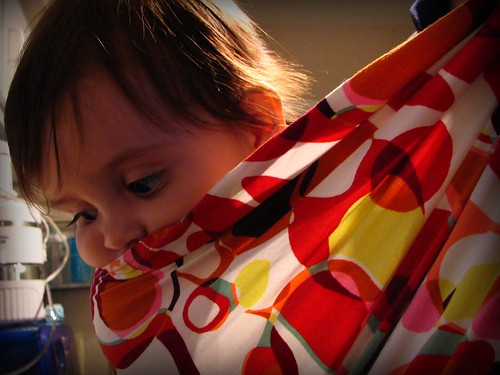Once past the early years, many parents come to API for information on how to continue raising children with attachment in mind. Today’s special guest blogger, Susan Stiffelman, explains how Attachment Parenting principles apply to the next phases of a child’s life.
Bonding with Children at Every Age
by MFT Susan Stiffelman
 Most of us know that a secure attachment to an attuned parent contributes enormously to a child’s developing sense of self, emotional resilience, and capacity for intimacy. Research has shown that when a child forms a strong attachment with a stable and loving caregiver in the first five years of life, his psychological health will be influenced for the better.
Most of us know that a secure attachment to an attuned parent contributes enormously to a child’s developing sense of self, emotional resilience, and capacity for intimacy. Research has shown that when a child forms a strong attachment with a stable and loving caregiver in the first five years of life, his psychological health will be influenced for the better.
But what if a healthy attachment doesn’t develop during a child’s formative years? Many parents worry that if mother was unavailable due to illness when she had her baby, or a child was adopted at age six, the window of opportunity for establishing a strong parent/child attachment will have been irretrievably lost, and their youngster will be incapable of forging deep attachments as an adult.
Alan Smoufe, Professor of Child Psychology in the Institute of Child Development at the University of Minnesota writes in March/ April 2011 Psychotherapy Networker, “Another important implication of attachment research is that it’s possible to develop a secure state of mind as an adult, even in the face of a difficult childhood. Early experience influences later development, but it isn’t fate: therapeutic experiences can profoundly alter an individual’s life course.”
In an ideal situation, the journey of attachment progresses smoothly from birth through young adulthood, empowering the child to venture forth into her ever-expanding world with a solid sense of self.
But it’s never too late to nourish a strong attachment with your child, regardless of his or her age. I have even seen profound shifts in the parent/child bond when the “child” was an adult. While there is plenty of evidence that the first years of life are critical when it comes to attachment, healing is always an option, even in a child’s later years.
Here are some tips for fortifying attachment with children as they grow up.
18 months:
Attunement is the key when bonding with an infant or baby. By letting your toddler know that you are present with him and reading his signals accurately at least most of the time, he relaxes into the safety of your presence.
Physical contact is a very important element in deepening attachment; cuddling and snuggling continue to help regulate a young child’s nervous system.
Your soothing voice is powerfully comforting. Sing, recite poems, or simply allow your child to bathe in the cadence of your calm words to strengthen connection.
5 years:
Play helps attachment deepen. Running, hiding, chasing and laughing all contribute to a stronger sense of connection between you and your child.
Physical contact is important, but make sure that all of you is available. Splitting your attention between your child and your Blackberry is not the same as being fully present with your child for at least a little time each day.
Seek out your child’s company (when she isn’t demanding it) with an invitation to do something unexpected, like playing a game of checkers or heading to the park. When you generously seek one on one time with your youngster, she feels liked, cherished and nourished.
10 years:
• Initiate a project that reflects one of your child’s non-academic interests, like drawing, baking or making music. This lets her feel you are genuinely interested in who she is, and who she’s becoming.
• Tell your child what—specifically—you like, love or admire about them. “No one tells a joke the way you do, sweetheart”, or “I love how patient you are with the neighbor’s little kids.” When a child feels seen by you for qualities that have nothing to do with accomplishments or achievements, it strengthens attachment.
• Listen to your child, and acknowledge the message underneath his words. If he knows you understand his emotional ups and downs—and can hear what he’s going through without jumping in with lectures or advice– it makes him feel close to you.
15 years:
Surprise your teenager with an unexpected “hookie” day, going somewhere neither of you have ever been before. Sharing new experiences is a wonderful way to fortify connection.
Shift your conversations from lectures and advice-giving to asking your teen’s opinions and ideas about a newsworthy or controversial topic, giving them the sense that you are genuinely interested in what they think and believe.
Show your teen that you are her ally, rather than adversary. If there’s a behavior or academic issue, approach it by coming alongside her, rather than at her with unwanted suggestions or demands. By feeling you’re on her side—even when things are rough—she’ll feel naturally connected to you, even if there’s conflict below the surface.
20 years:
Ask your adult son or daughter how often they’d like to be in touch, and respect their wishes, keeping in mind that frequency will change—often rapidly—depending on what they’re going through at any given time.
Stay connected with text messages or short emails with news from home that help your young adult feel close to you without feeling suffocated with long phone calls.
Don’t take a young adult’s infrequent contact personally. Make sure he hears the warmth in your voice when you do talk, and knows that you’re there in the background if he needs an emotional lift, while trusting him to rely more on himself to get through life’s ups and downs.
Every child—regardless of their age—longs to have a healthy connection with their parent. It is never too late to work on developing a deep connection with your children. My mom and I have grown enormously closer in the last few years, and she is in her eighties! So don’t give up if things between you and your child feel distant or awkward. Take one step at a time toward fortifying attachment, and you will both be richly rewarded.
Susan Stiffelman is the author of Parenting Without Power Struggles: Raising Joyful, Resilient Kids While Staying Cool, Calm and Connected, released in March, 2012 by Atria Books, a division of Simon and Schuster. Ms. Stiffelman is a licensed Marriage, Family and Child therapist, a K-9 credentialed teacher, an educational therapist and a sought after parenting coach. Her approach focuses on helping parents be the calm, confident “Captain of the ship” that children naturally want to cooperate with, confide in, and respect. Susan is the weekly staff parenting expert (“Parent Coach”) for the Huffington Post where her columns have garnered an international following. Susan weighs in on issues relevant to every age group and demographic, ranging from toddler meltdowns, tweens who sass back, and teens who may be struggling with depression or substance abuse.. Susan periodically offers articles for Psychology Today, Gaiam, More.com and other sites.








